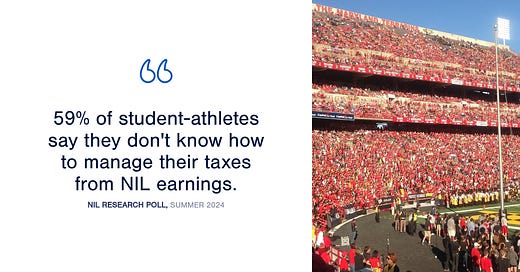Death and Taxes
7 Action Steps to Prepare Student-Athletes for Tax Season: What Coaches, Administrators, and Advisors Need to Share
As the calendar year winds down, student-athletes earning income through NIL (Name, Image, Likeness) opportunities are approaching a critical period: tax season. For many, this may be the first time they face tax obligations, and the stakes are high. Misinformation or lack of preparation can lead to financial headaches or even legal troubles.
Here’s what you, as coaches, administrators, and service providers, need to communicate to help your student-athletes navigate this challenge confidently.
1. Taxes Are Inevitable—Prepare for Them Early
Student-athletes need to understand that any income earned through NIL activities is taxable. This includes:
Cash payments
In-kind compensation (like free products or gift cards)
Revenue from social media promotions, appearances, or camps
Action Step:
Encourage athletes to set aside 35-40% of their pre-tax earnings to cover federal, state, and self-employment taxes. Opening a separate savings account specifically for taxes can simplify this process.
2. Federal and State Tax Obligations
The federal government taxes NIL income at rates ranging from 10% to 37%, depending on total earnings. For many student-athletes, federal tax liability begins at $12,950 (the standard deduction for single filers in 2023).
State taxes add another layer of complexity. Athletes may owe taxes both in their home state (where they claim residency) and in states where they earned NIL income.
For example: An athlete attends school in Florida (no state income tax) but earns income from appearances in New York (state income tax required).
Action Step:
Advise student-athletes to consult a tax professional to determine where they owe state taxes and to avoid surprises.
3. Self-Employment Taxes and 1099 Forms
Most NIL income is considered self-employment income. This means:
Student-athletes must pay a 15.3% self-employment tax in addition to federal and state income taxes.
Entities paying them over $600 in a calendar year are required to issue a 1099 form. Athletes should track all NIL-related income, even if they don’t receive a 1099.
Action Step:
Help student-athletes maintain a record of all NIL income and expenses throughout the year. Tools like spreadsheets or budgeting apps can make tracking easier.
4. Business Deductions: Save Money on Taxes
Student-athletes can deduct certain business-related expenses from their taxable income, reducing their overall tax liability. These may include:
Travel expenses for NIL-related activities
Equipment or clothing used for promotional work
Marketing materials or professional photography
Fees paid to agents, advisors, or tax professionals
Action Step:
Encourage athletes to keep receipts and detailed records of expenses tied to their NIL activities. Consider introducing them to a tax preparer familiar with self-employment deductions.
Subscribe to NIL/edu to unlock the rest of “Death and Taxes,” including info on Financial Aid, Deadlines & Filing, and the Role of Advisors.
NIL/edu is a reader-supported publication. Become a paying subscriber for $5 per month to get access to this edition, 4 newsletters per month, and all past subscriber-only content.
Keep reading with a 7-day free trial
Subscribe to NIL/edu to keep reading this post and get 7 days of free access to the full post archives.




